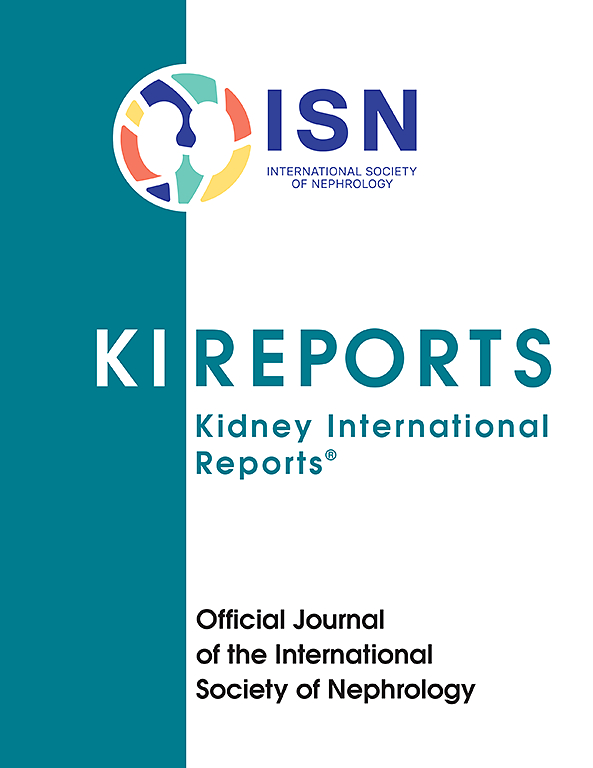液体活检-多组学:黏附通路失调与肾损伤严重程度相关
IF 5.7
2区 医学
Q1 UROLOGY & NEPHROLOGY
引用次数: 0
摘要
严重急性肾损伤(AKI)与发展为慢性肾脏疾病的风险密切相关;然而,对细胞类型特异性机制驱动肾损伤严重程度知之甚少。方法在这项多中心观察性研究中,我们使用临床获得的液体活检蛋白质组学和机器学习(ML)来预测covid相关和非covid AKI患者的严重结局。此外,我们将169个尿液蛋白质组学样本与437个血浆蛋白质组学样本和40个尿液沉积物单细胞转录组学样本正交结合,以确定互补的失调机制。使用10倍交叉验证随机森林算法,我们确定了一组尿蛋白,其发现集和验证集的AUC分别为87%和76%。获得的这些预测性蛋白质组学特征表明,细胞粘附和自噬相关途径在严重AKI中受到独特的影响。与这些通路相关的差异丰富蛋白(DAPSs)在近髓肾细胞、内皮细胞(ECs)和足细胞中高度表达,表明这些肾细胞类型可能是潜在靶点。在感染SARS-CoV-2的肾类器官体外模型中进行单细胞转录组学分析,揭示了多个肾单元段细胞外基质(ECM)组织的失调,概括了临床观察到的纤维化反应。足细胞和小管类器官簇的配体-受体相互作用分析显示,在感染的肾类器官中,整合素和基底膜受体之间的相互作用显著减少和丧失。综上所述,这些数据表明ECM降解和粘附相关机制可能是严重肾损伤的主要驱动因素。本文章由计算机程序翻译,如有差异,请以英文原文为准。

Liquid Biopsy-Multiomics Link Adhesion Pathway Dysregulation to Kidney Injury Severity
Introduction
Severe acute kidney injury (AKI) is strongly associated with the risk of developing chronic kidney disease; however, little is known about the cell type–specific mechanisms driving kidney injury severity.
Methods
In this multicenter observational study, we used clinically obtained liquid biopsy proteomics and machine learning (ML) to predict severe outcomes in patients with COVID-associated and non-COVID AKI. Further, we orthogonally combined 169 urine proteomics with 437 plasma proteomics samples and 40 urine sediment single-cell transcriptomics samples to identify complementary dysregulated mechanisms.
Results
Using a 10-fold cross-validated random forest algorithm, we identified a set of urinary proteins that demonstrate predictive power for both discovery and validation set with AUC of 87% and 76%, respectively. These predictive proteomics features obtained demonstrate that cell adhesion and autophagy-associated pathways are uniquely impacted in severe AKI. Differentially abundant proteins (DAPSs) associated with these pathways are highly expressed in cells of the juxtamedullary nephron, endothelial cells (ECs), and podocytes, indicating that these kidney cell types could be potential targets. Single-cell transcriptomic analysis in the in vitro model of kidney organoids infected with SARS-CoV-2 reveal dysregulation of extracellular matrix (ECM) organization in multiple nephron segments, recapitulating the clinically observed fibrotic response across multiomics datasets. Ligand-receptor interaction analysis of the podocyte and tubule organoid clusters shows significant reduction and loss of interaction between integrins and basement membrane receptors in the infected kidney organoids.
Conclusion
Collectively, these data suggest that ECM degradation and adhesion-associated mechanisms could be the main driver of severe kidney injury.
求助全文
通过发布文献求助,成功后即可免费获取论文全文。
去求助
来源期刊

Kidney International Reports
Medicine-Nephrology
CiteScore
7.70
自引率
3.30%
发文量
1578
审稿时长
8 weeks
期刊介绍:
Kidney International Reports, an official journal of the International Society of Nephrology, is a peer-reviewed, open access journal devoted to the publication of leading research and developments related to kidney disease. With the primary aim of contributing to improved care of patients with kidney disease, the journal will publish original clinical and select translational articles and educational content related to the pathogenesis, evaluation and management of acute and chronic kidney disease, end stage renal disease (including transplantation), acid-base, fluid and electrolyte disturbances and hypertension. Of particular interest are submissions related to clinical trials, epidemiology, systematic reviews (including meta-analyses) and outcomes research. The journal will also provide a platform for wider dissemination of national and regional guidelines as well as consensus meeting reports.
 求助内容:
求助内容: 应助结果提醒方式:
应助结果提醒方式:


